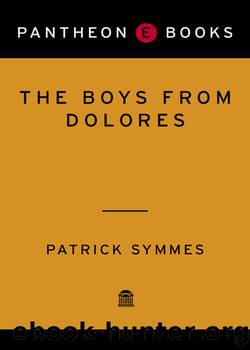The Boys from Dolores by Patrick Symmes

Author:Patrick Symmes
Language: eng
Format: epub
ISBN: 9780375425189
Publisher: Knopf Doubleday Publishing Group
Published: 2007-07-10T00:00:00+00:00
âDios mÃo,â Elizardo Sánchez said when I showed him the 1941 photograph, with its 238 faces. âThis is the key to Cuba before the Revolution.â
As was proving the case across Cuba, I didnât need to introduce the photograph or explain it. He knew what it was, immediately. Sánchez himself was puro oriental. Heâd grown up in Santiago, and in the 1940s and 1950s had walked by the Colegio Dolores âa million times,â he said. But heâd never set foot in the school.
âFor me it was impossible to dream of going inside those high walls. My father was a telegrapher. You know,â he said, tapping a code onto the tabletop, âhe sent letters. So I went to a government school, a public school.â
The dominant reality for Dolores students, Sánchez said, was their class. They lived within the bubble of privilege. âThey had little contact with the ordinary people,â Sánchez said. They were the sons of wealthy landowners, and the scions of successful professionals. They lived in the best neighborhoods, in the biggest houses, surrounded by servants. Their families had cars.
âHalf the students were residents, and rarely left the building,â Sánchez recalled, not quite accurately. âThe other half were day students. They had a special bus, a really nice bus, painted up to read COLEGIO DOLORES, that took them home. I remember seeing that bus going through the streets, heading to their big houses in Vista Alegre. It was a privilege.â
Although I had found some in Santiago and would now look for them in Havana, Sánchez assured me that most of the Dolores boys had gone into exile. He was in the unusual position for a Cuban of actually knowing what life was really like for the exiles, since heâd met many while visiting America. Heâd even known Lundy Aguilar slightly; although they had grown up on opposite sides of the Dolores walls, they had met in the United States and shared ideas about nonviolence and the importance of dialogue.
Going into exile simply substituted new problems for old ones, Sánchez said. In America, the Cubans were still âstrangers,â lost to their own roots. Even if they succeeded in re-creating portions of their old Cuban lives in Floridaârequalifying in their professions, buying new houses, rebuilding their fortunesâit was never enough, nor entirely genuine. One world had come to an abrupt halt; the other had never quite resumed. They didnât know Cuba, as it was now, and lived without fully participating in the life of America, Spain, Mexico, or wherever they ended up. âThereâs a double isolation,â Sánchez said. âLundy has said that his clock stopped in 1959. His view of Cuba is of the society before.â
But even the boys from Dolores who had never left Cuba were still in isolation, Sánchez suggested. Their privileges, their fortunes, lives, homes, and country had all changed around them, while the culture and values they grew up with were locked in amber.
âInxilioâ was the word Sánchez used. Inxile. Internal exiles. Another coinage to paper over the cracks in reality.
Download
This site does not store any files on its server. We only index and link to content provided by other sites. Please contact the content providers to delete copyright contents if any and email us, we'll remove relevant links or contents immediately.
| Antigua | Bahamas |
| Barbados | Cuba |
| Dominica | Dominican Republic |
| Grenada | Haiti |
| Jamaica | Saint Kitts |
| Saint Lucia | Saint Vincent |
| Trinidad and Tobago |
Cat's cradle by Kurt Vonnegut(15256)
Pimp by Iceberg Slim(14433)
4 3 2 1: A Novel by Paul Auster(12329)
Underground: A Human History of the Worlds Beneath Our Feet by Will Hunt(12052)
The Radium Girls by Kate Moore(11970)
Wiseguy by Nicholas Pileggi(5707)
The Fire Next Time by James Baldwin(5380)
Perfect Rhythm by Jae(5354)
American History Stories, Volume III (Yesterday's Classics) by Pratt Mara L(5274)
Paper Towns by Green John(5136)
Pale Blue Dot by Carl Sagan(4953)
A Higher Loyalty: Truth, Lies, and Leadership by James Comey(4905)
The Mayflower and the Pilgrims' New World by Nathaniel Philbrick(4458)
The Doomsday Machine by Daniel Ellsberg(4449)
Killers of the Flower Moon: The Osage Murders and the Birth of the FBI by David Grann(4409)
The Sympathizer by Viet Thanh Nguyen(4338)
Too Much and Not the Mood by Durga Chew-Bose(4302)
The Borden Murders by Sarah Miller(4275)
Sticky Fingers by Joe Hagan(4143)
